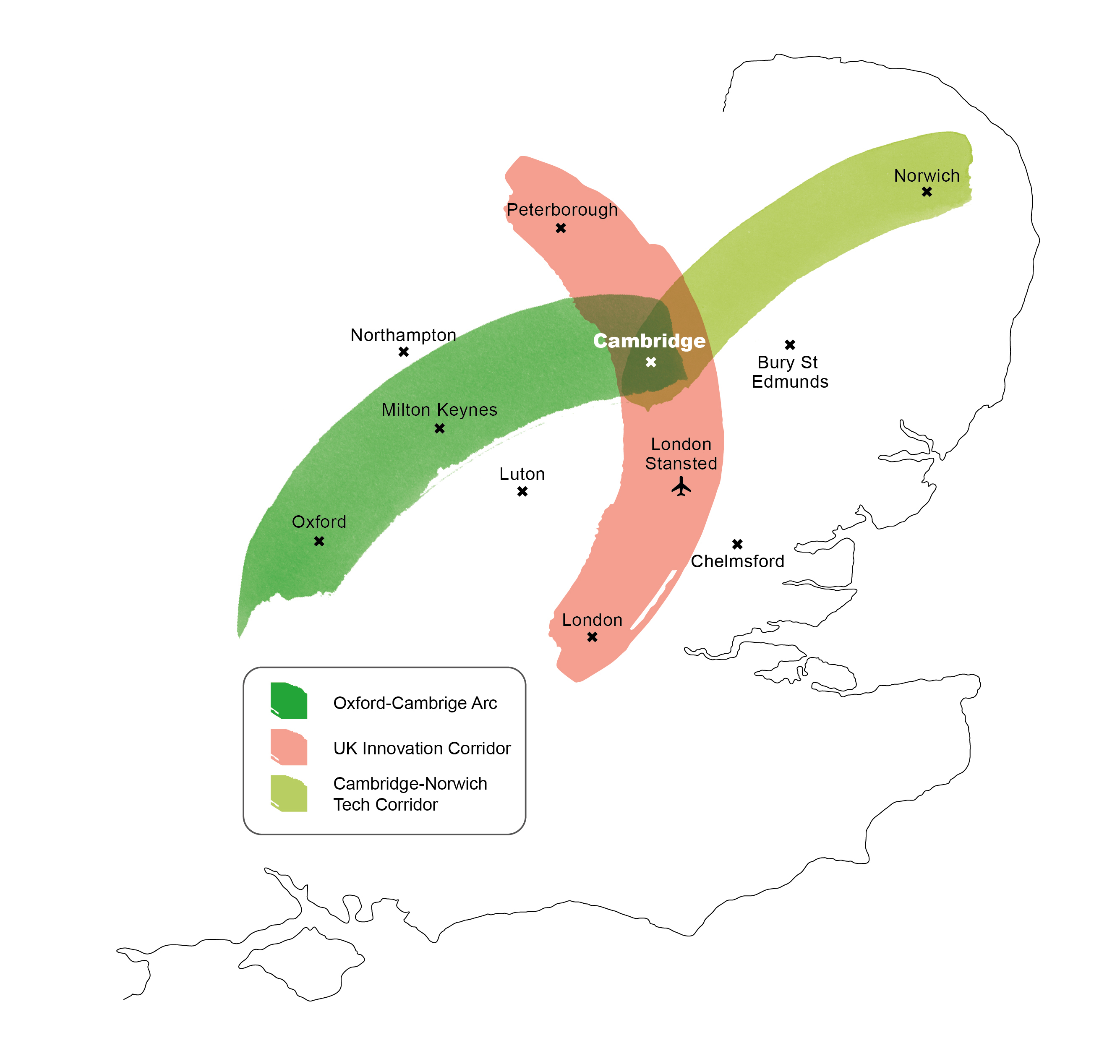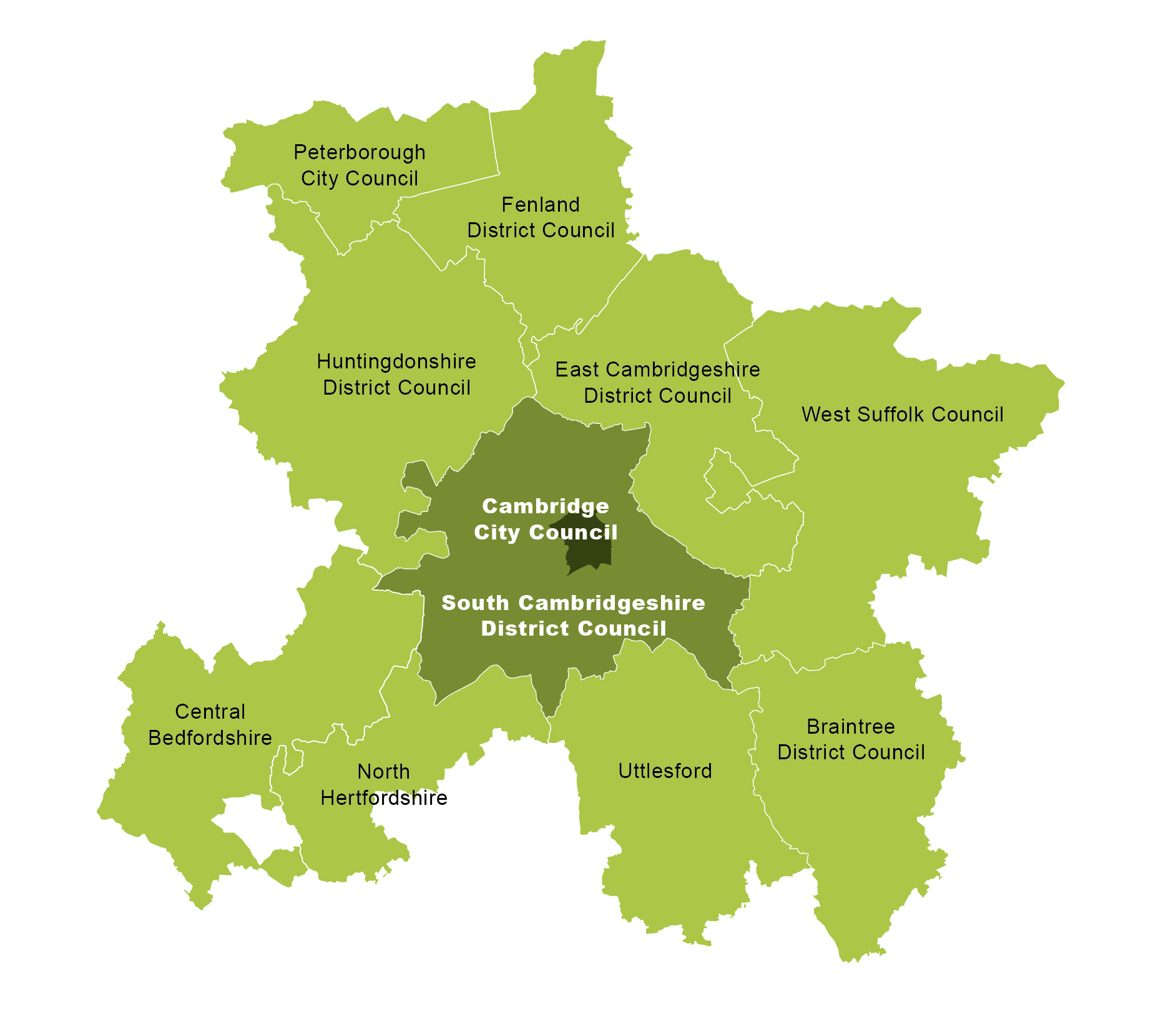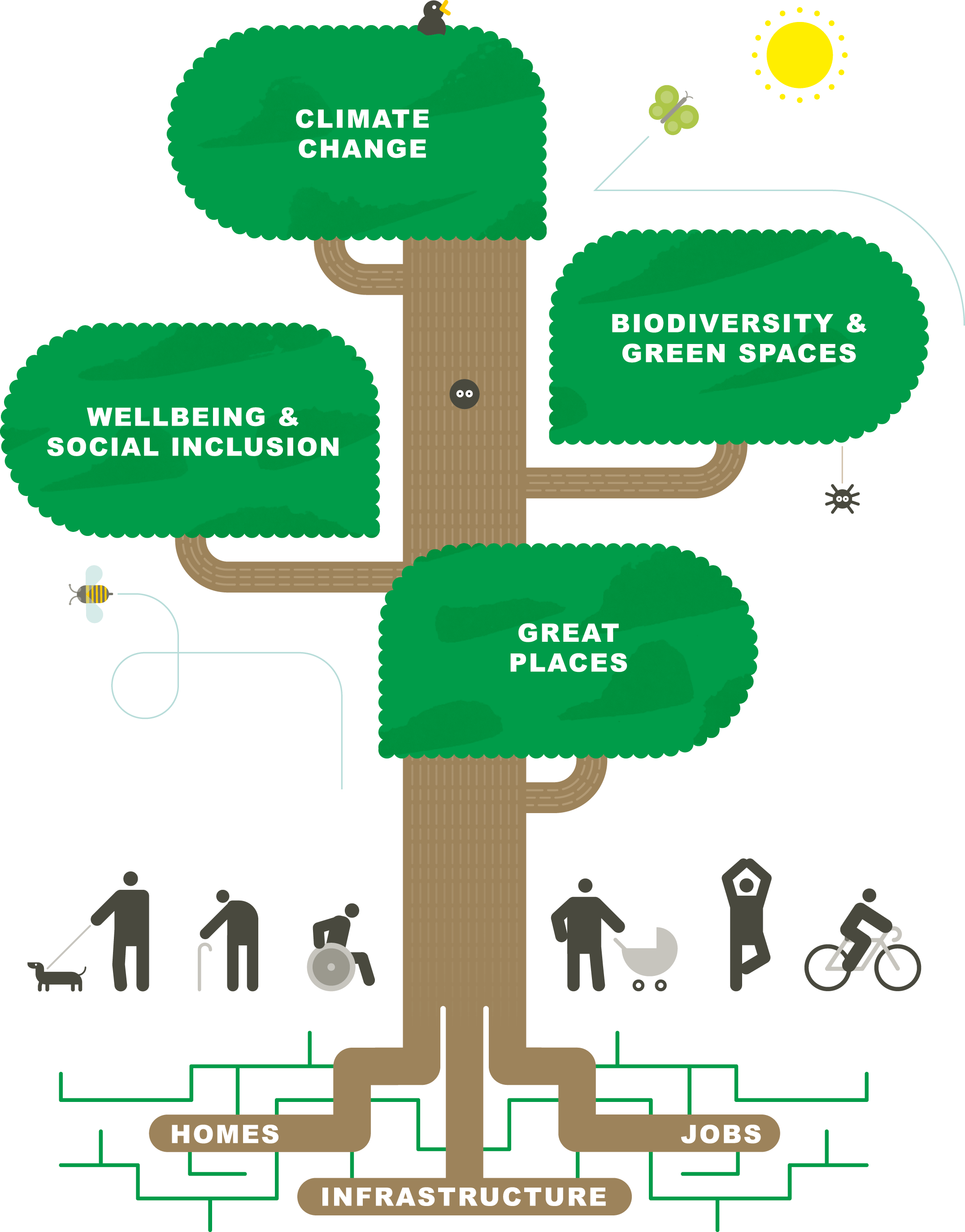What is the Greater Cambridge Local Plan?

Cambridge City Council and South Cambridgeshire District Council (referred to as ‘the Councils’ in this consultation) are working together to create a joint for the two areas – which we are referring to as . This will ensure that there is a consistent approach to planning, and the same planning policies, where appropriate, across both areas.
A is a legal document that the Councils are required to prepare, which sets out the future land use and planning policies for the area over a set time frame. It identifies the need for new homes and jobs, and the services and infrastructure to support them, and guides where this development should happen.
In the past the Councils have produced separate Local Plans, but with a shared development strategy, including a number of development sites straddling the administrative boundary. This time we intend to prepare a single for both Council areas. We committed to do this when we signed up to the City Deal in 2014, which will bring in up to £500m over a 15-year period from central government towards transport and infrastructure projects managed by the Partnership.
Both Councils adopted their current Local Plans in 2018. These included a commitment to an early review, in particular to update the assessment of housing needs, to review the progress of delivering planned developments including new settlements, and to consider the needs of caravan dwellers and government changes to the approach to planning for . When adopted, the would replace both Council’s 2018 Local Plans. The adopted 2018 Local Plans remain in force until they are replaced.
preparation follows a process set out in national legislation and guidance and is independently tested at a public examination to check it is ‘sound’ – this means that it is realistic, deliverable and based on good evidence – before it can be formally adopted.
Local Plans are key in making decisions on future planning applications in the area, alongside national planning policy and other supplementary guidance.
How does it fit with other plans and strategies?
Our new needs to be prepared within a wider regional context. We have a legal duty to cooperate with key stakeholders and surrounding areas on strategic cross boundary issues. You can find more information in our Duty to Cooperate Compliance Statement and Statement of Common Ground.
We work closely with bodies like the Cambridgeshire and Peterborough Combined Authority, who are the Local Transport Authority responsible for preparing the Local Transport Plan for the county, and Cambridgeshire County Council, who are responsible for a range of issues such as education.
At a very local level, Neighbourhood Plans continue to be prepared in . At the time of writing there are four plans which have been prepared and endorsed by communities, which now form part of the statutory development plan for the area. A number of villages are producing plans, and you can find out more on our neighbourhood planning website.
The Oxford-Cambridge Arc
sits at the heart of several economic corridors: the Oxford-Cambridge Arc, the UK Innovation Corridor (London-Stansted-Cambridge-Peterborough) corridor and the Cambridge-Norwich Tech Corridor.
The is a globally significant area including the counties between Oxford, Milton Keynes and Cambridge, identified as a key priority by the government.
The ambition for the Arc is to build a better economic, social and environmental future for the area. There is an opportunity to make the Arc an even more beautiful place to live, work and visit, by making high-quality, well-connected and sustainable communities.
An Spatial Framework is being prepared which will provide a long-term strategic plan to help coordinate the infrastructure, environment and new developments in the area up to 2050. When finalised it will become part of government planning policy alongside the National Planning Policy Framework.
The Government held a 12 week consultation which closed on 12 October 2021 seeking views on the vision for the Arc. The Government plan to follow this with further consultations, on policy options in Spring 2022, and the draft spatial framework in Autumn 2022 prior to its final publication in 2023.
We do not know the outcome of the Oxford-Cambridge framework at this point. We hope that by developing our own clear and positive vision for the future of the area we will be able to shape the proposals.

Our plan-making journey

The diagram above shows the outline timetable that is included in the adopted Local Scheme. The Local Scheme is a document we are required to produce which sets out our plan making timetable. At each stage we will check that the process is moving forward positively towards a new and, if necessary, we will adjust the timetable.
Our plan making journey started back in 2019 with a series of workshops with elected members, residents' groups, landowners/developers, and other stakeholders about issues and themes that would be important to the Plan.
In early 2020 we held a six week public consultation called the First Conversation. This set out issues under seven themes, and posed a series of questions about how they should be addressed in the new . During the consultation period, extensive outreach and communications activities took place in order to engage our communities as fully as possible. This included using social media to spread awareness of the consultation, pop-up events across the area, and the Big Debate event that we held at the Cambridge Corn Exchange.
We received a large amount of feedback through the various communication channels. In July 2020 we published the feedback and comments we received, and the full results can be found on the Shared Planning Service website. This included all the sites suggested to us through the ‘call for sites’ which formed part of the consultation.
In November 2020 we published the findings of initial expert assessments of a range of broad spatial locations and growth level options. You can read the findings, including the Strategy Options Summary Report, in the Document Library. We also held another series of workshops with key stakeholders to explore these findings.
We have produced a Consultation Statement which provides more information on the consultation we have carried out so far, and how we have taken feedback into account. We will update this at each stage of plan making.
The purpose of the First Proposals stage
The First Proposals stage is the next major step in our plan making journey. It sets out our preferred approach to the level of growth that should be planned for, and where it should be planned. It also highlights that there remains uncertainty about delivery of water infrastructure needed to support new growth, and how this could impact on the timing of developments proposed.
It describes the planning policies we propose to prepare that would shape development and guide planning decisions. It sets out why we have identified these approaches against the alternatives available.
The purpose of the consultation is to invite responses to these proposals from residents and businesses as well as stakeholders and other organisations. We want to hear your views before we develop the approaches into detailed planning policies. In particular we would like your feedback on:
- The emerging development strategy
- The direction of travel for policies
- Issues we should be considering as policies are prepared
In legal terms, this consultation forms part of our consultation under Regulation 18 of the Town and Country Planning (Local Planning) (England) Regulations 2012.
What happens after the First Proposals stage?
We hope to receive a wide range of feedback, including from individuals, communities, businesses, academic institutions and stakeholders during this consultation on the options identified. All the comments received during the consultation will be analysed and a summary report produced and published on our websites.
This feedback will be invaluable as we start to draft the itself.
We are still working on and refining evidence to inform the draft plan. This process will continue over the coming months. This includes further consideration of water resource availability to support the delivery timetable of the developments proposed, and the potential implications for the plan. More information on this can be found in the strategy section.
Our current Local Scheme sets out that in 2022 we will publish the draft and all evidence supporting the plan for public consultation, allowing people to comment on the fully detailed policies and allocation proposals. We will keep this timetable under review and this may be revised dependent on a number of factors including evidence, comments received through consultation, progress on key infrastructure and the spatial framework.
The later stages of the timetable may also depend on the timetable of the Consent Order proposals for the Cambridge Waste Water Treatment Plant Relocation Project. This is because we need to have evidence of whether the North East Cambridge proposals (see Strategy, S/NEC) that form a key part of the development strategy are deliverable, so we will need to understand the outcome of this process.
In 2024 the Councils expect to publish the plan they intend to submit to the Secretary of State for adoption. Representations made at that stage will be considered by the independent Inspector at an Examination of the plan. The inspector will prepare a report, and consider if the plan is sound and can be adopted.
This process may be affected by changes to the planning system being considered by the government. They published a White Paper in 2020 called Planning for our Future which proposed significant changes to what Local Plans would cover and how they would be prepared. We do not yet know the outcome of this consultation.
Further updates of the timetable will be published on our website in our Local Scheme.
The structure of the new Local Plan

Our must provide a positive vision for the future of . The aim is simple: to ensure sustainable development. Sustainable development has three strands - social, economic and environmental. It means meeting the needs of the present population without compromising the ability of future generations to meet their own needs. To properly reflect the three strands of sustainable development, we must plan for homes, jobs and supporting infrastructure (transport, utilities, services and facilities) in the right places, alongside protecting and enhancing the environment. In order to achieve this, we will need to balance many competing priorities and issues.
In the First Conversation we proposed that the plan be structured around four ‘big themes’ that will influence how homes, jobs and infrastructure are planned. We received lots of feedback on all of these, but the majority of respondents supported the approach. We therefore continue to use them to shape the plan.
In addition to the themes, the First Proposals consultation includes the strategy that the plan is proposing, which has been influenced by all of the themes and sets out the development strategy and the proposed policies and sites that are proposed to meet our needs in to 2041 and beyond.
Evidence informing the new Local Plan
Preparing a requires gathering the appropriate level of evidence to inform the preparation of the plan, as required by national policy.
In November 2020 we published initial evidence base findings and development strategy options assessments. This evidence explored a range of broad spatial locations and growth level options.
A range of further evidence studies have now been published to accompany the First Proposals consultation. These can be found in the First Proposals Document Library.
Sustainability Appraisal
A key role of the planning system is to contribute to sustainable development. Each stage of plan making will be accompanied by a Sustainability Appraisal. The aim of this process is to test the options and policies being considered by identifying potential positive and negative social, economic and environmental impacts, and highlighting opportunities to improve the plan.
As part of the First Conversation, we consulted on a Scoping Report, which sets out our approach to the appraisal of the plan, along with an initial Sustainability Appraisal of the Issues and Options identified. Comments on these documents have been taken into account and responded to.
The First Proposals have been subject to sustainability appraisal, and this has been published to accompany the consultation. This explores the sustainability of the preferred options in the First Proposals and reasonable alternatives. We would welcome comments on the Sustainability Appraisal as part of this consultation.
Tell us what you think about the Sustainability Appraisal
You can find the Sustainability Appraisal and associated appendices in the Document Library.
Our consultation for this phase is now closed.
Tell us what you think about the Habitats Regulation Assessment
You can find the Habitats Regulation Assessment and associated appendices in the Document Library.
Our consultation for this phase is now closed.